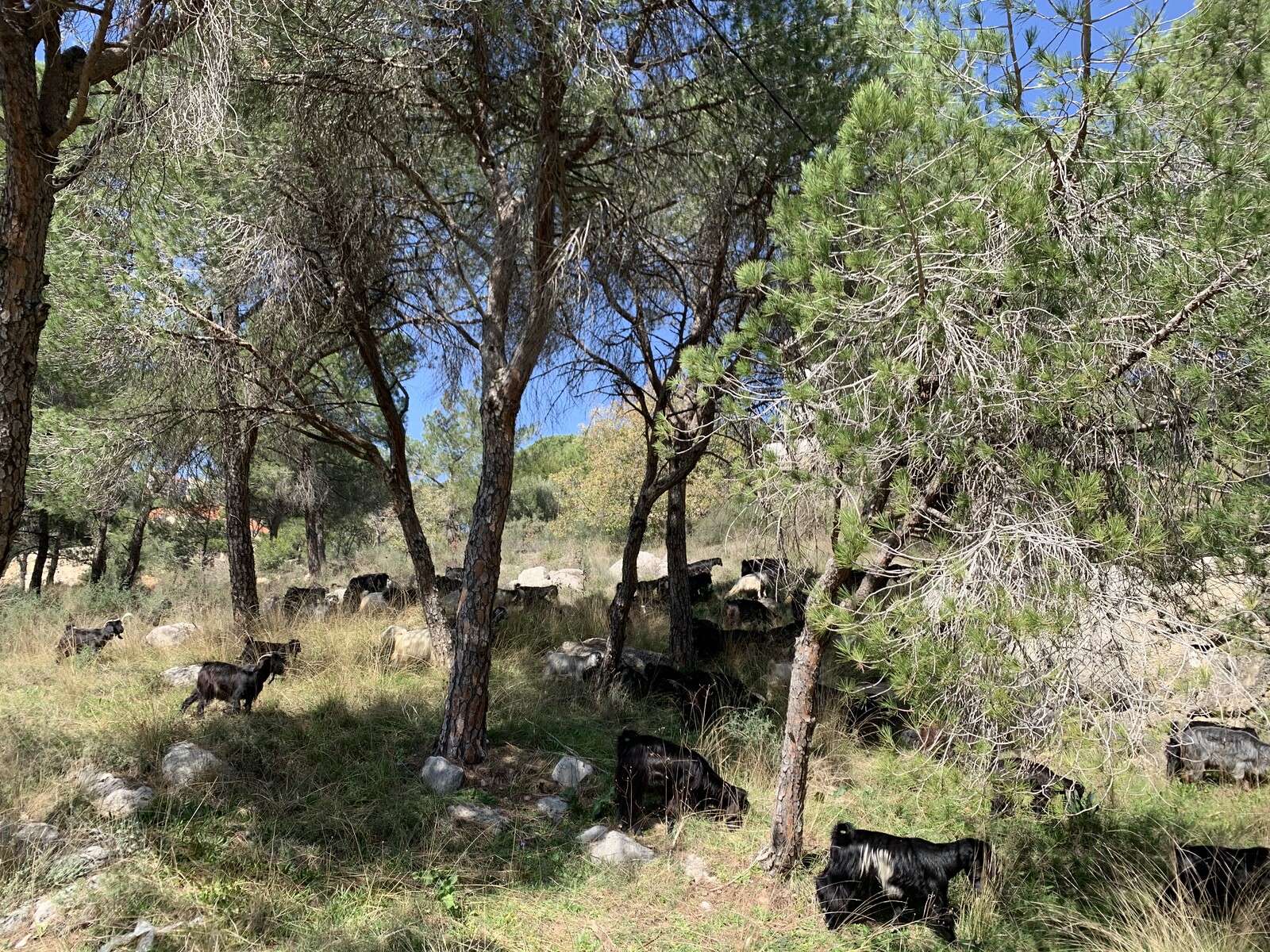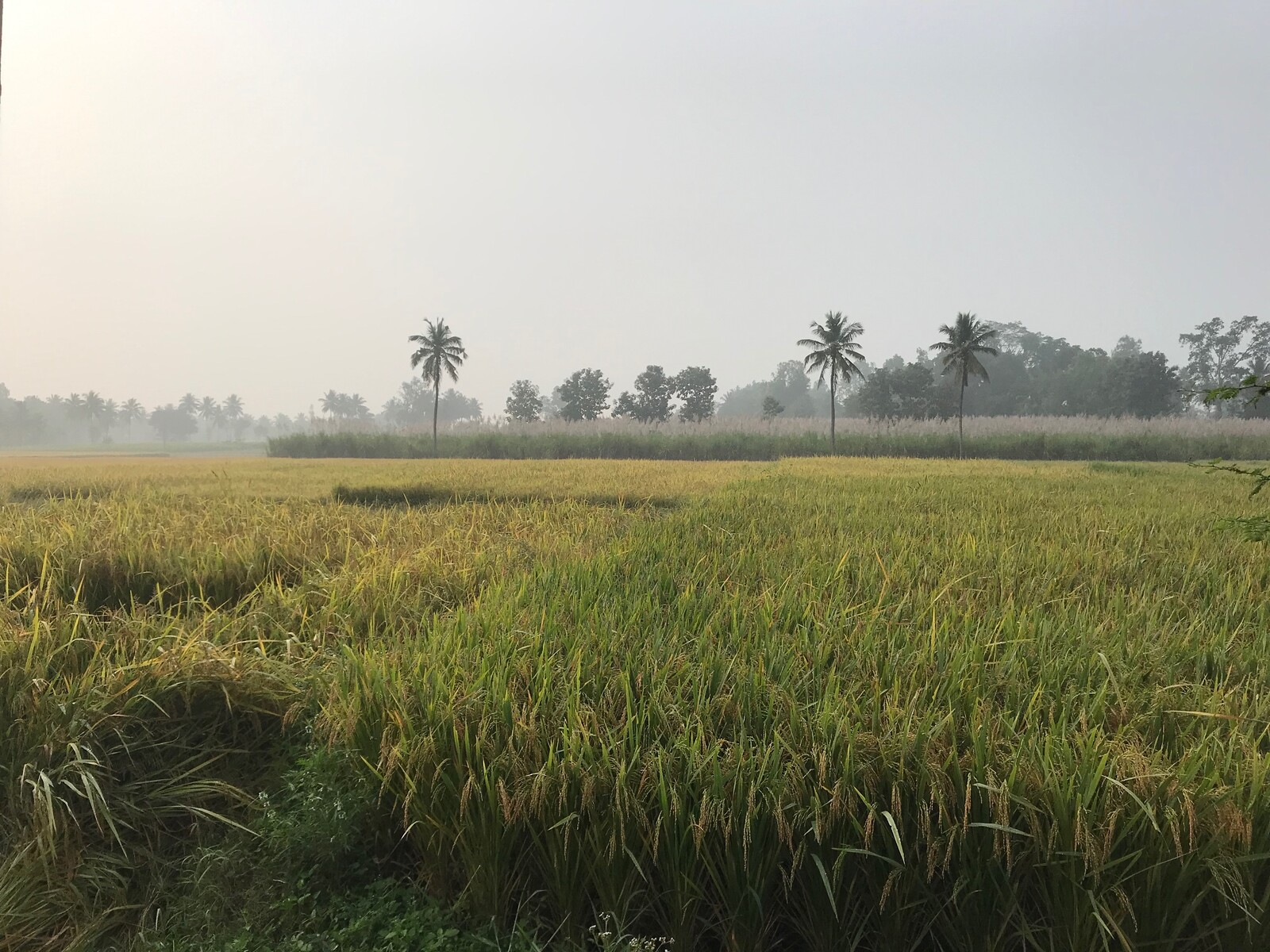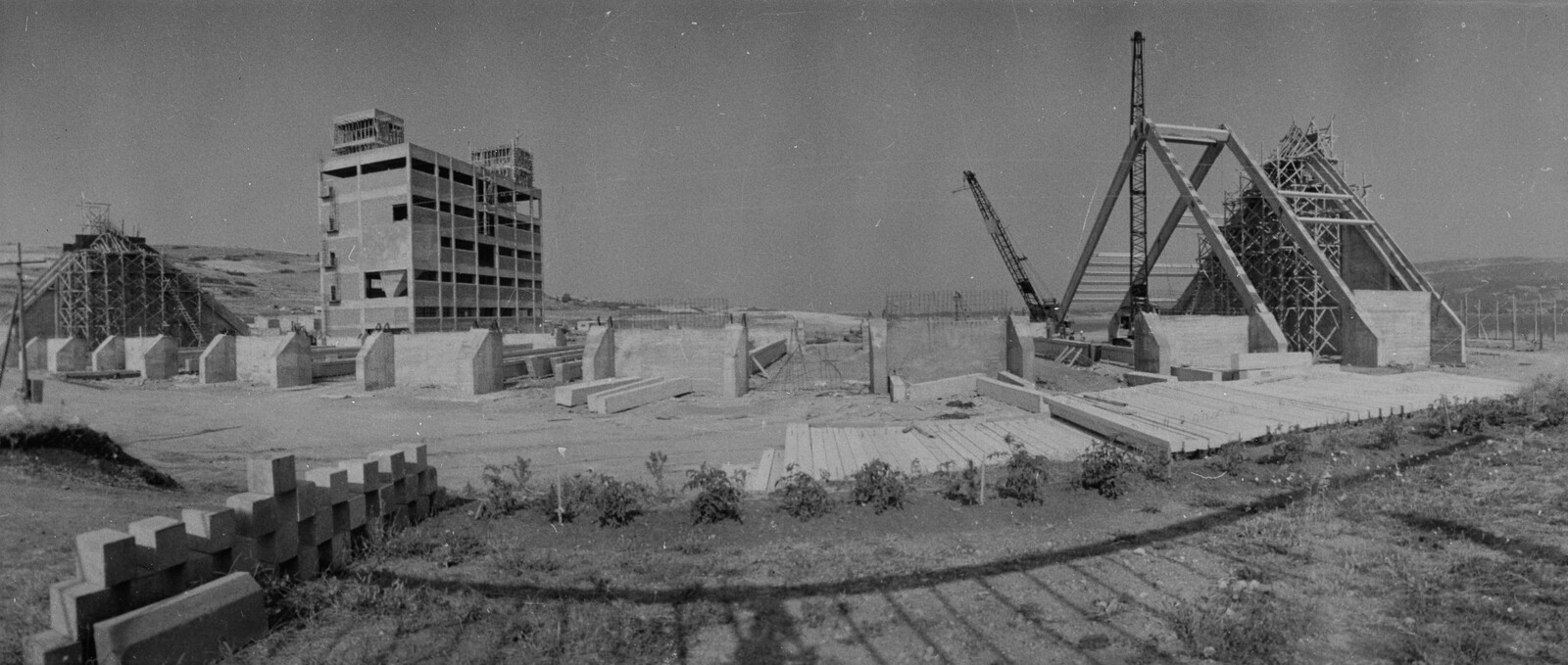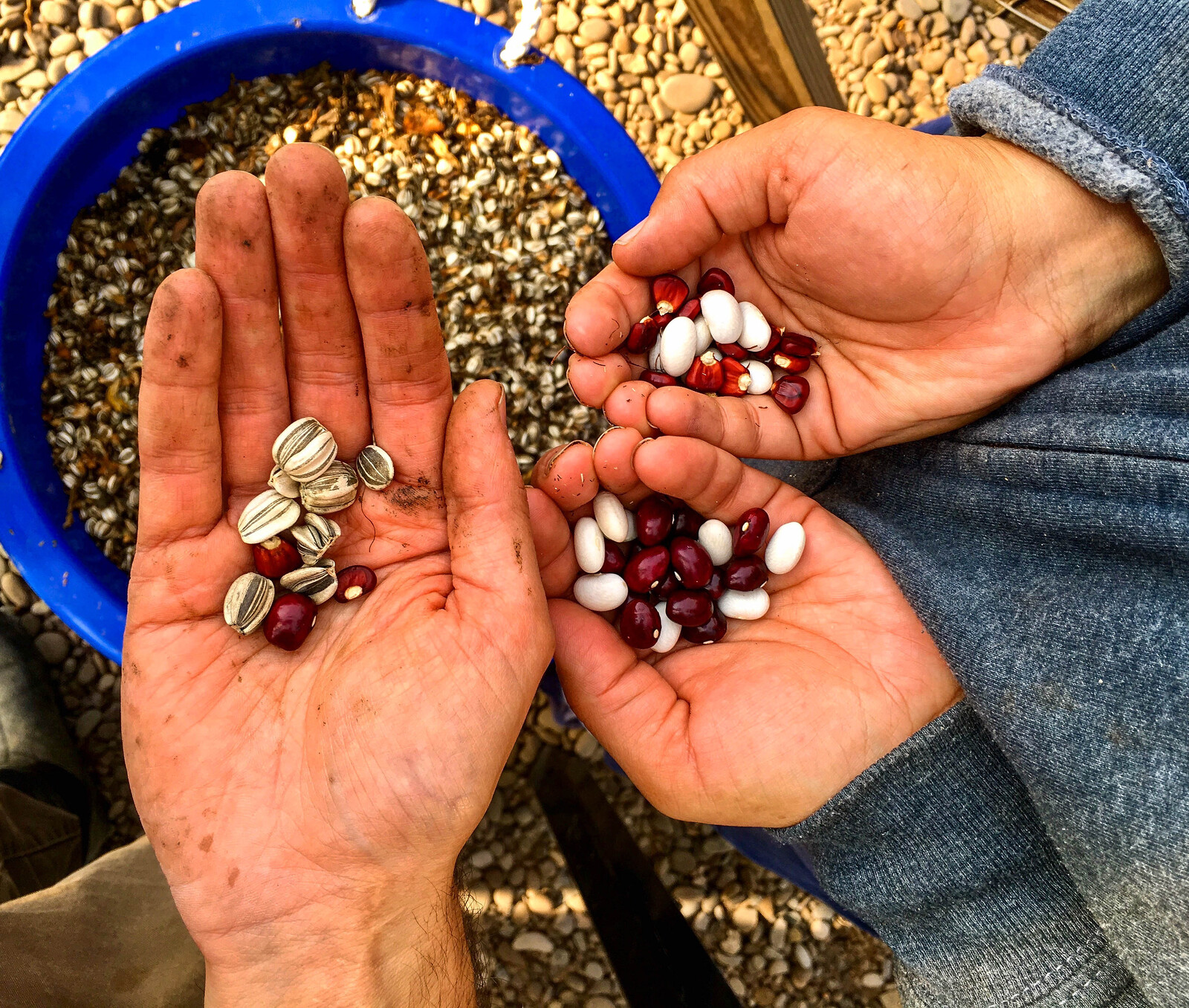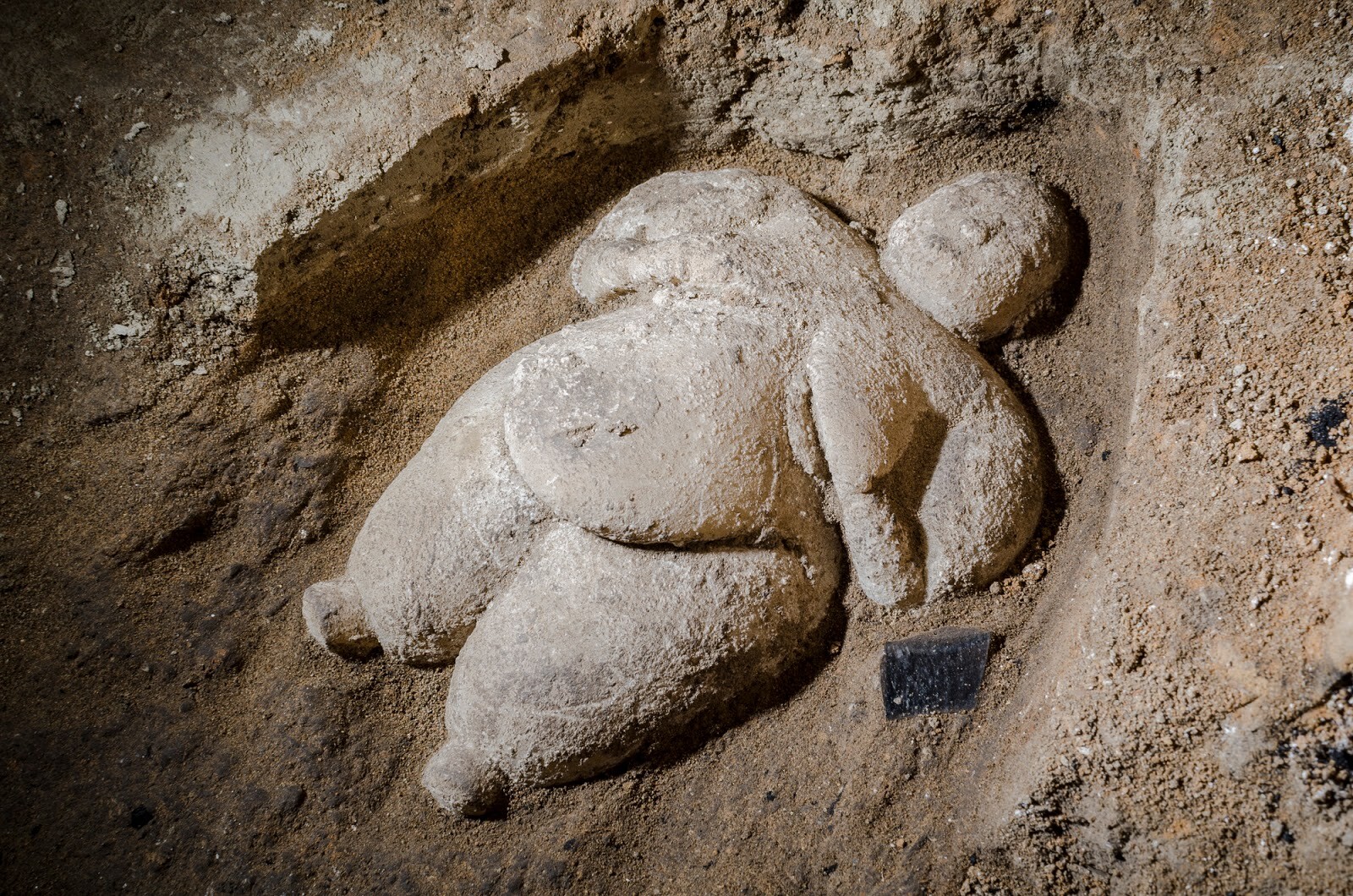The In/Fertile Crescent
From the delta of the Tigris-Euphrates to the valley of the Jordan river, curving around the Great Syrian Desert and passing through the foothills of the Anatolian mountains, lies the Fertile Crescent. Here, culture and agriculture were once inseparable, for it is from this land that farming has emerged; it is in this soil that domesticated staples such as wheat and barley were first sown. This is the land of the powerful city states of Tyre, Babylon, Ur, and Uruk, the playground of the Gods of Mesopotamia, Aram, and Canaan, and the birthplace of the Abrahamic religions. From here, deities, seeds, humans, and domesticated animals traveled to Europe and to the Nile valley, carried by armies fed by the surplus of grain produced on elaborately irrigated fields. The gods, cattle, plants, and humans merged into interdependent socio-ecological polities that nurtured the philosophers and conquerors who laid the cornerstones of the modern world.
But time was not kind to the Fertile Crescent. The region that saw the birth of agriculture has now become one of the world’s largest importers of food. In the valleys of the five rivers, the arable soils—once rich and productive—have lost much of their vitality.1 Farmers who tilled the earth in symbiosis with cattle herders and enriched their soils with manure rely today on large additions of synthetic fertilizers. The waters of the rivers, once bearers of life, now carry salt, sewage, and weapon-grade depleted uranium. War and occupation appear to have anchored themselves permanently to the fatigued earth.
At the south-western tip of the Fertile Crescent, its foothills plunging into the Mediterranean, lies the mythical Mount Lebanon, known since antiquity for its imposing cedars and its powerful Phoenician city states. From ports carved into its narrow littoral plain, Phoenicians merchants sailed through the Mediterranean, established trading posts from North Africa to the Iberian Peninsula. They crossed the Pillars of Hercules, the gateway to the Atlantic, and explored the coast of Britain. They sold regal fabrics dyed with Tyrean purple which they exchanged for gold and silver. On the coastal plains, on the terraced hills, and in the rich soils of Coele-Syria (today’s Beqaa valley) they grew cereals, grain legumes, olives, and grapes, made wine, and built temples to Baal, Eshmun, Ishtar, and Adon.
The days when Phoenicians dominated the Mediterranean trade are long gone. The fabled cedars were felled to satisfy the vanity of demigods, warriors, pharaohs, and caesars from Mesopotamia, Egypt, and Rome, as well as to quench the cupidity of the Phoenician traders. One hundred years ago, a nation state—Lebanon—was created on the remains of the Ottoman Empire.2 Over the course of the past century, the country has mostly known civil wars, invasions, and occupation. Lebanon is today mired in internal and external conflicts and burdened by a collapsed economy and a deadly pandemic. It is largely dependent on food imports, for the exhausted lands and the depleted soils cannot provide for its inhabitants. And on August 4, 2020, the country was brought to its knees by a devastating explosion that destroyed part of the port of Beirut as well as a significant sector of the city. What was described as one of the largest non-nuclear explosions in recent times was caused by the deflagration of nearly 3,000 metric tons of ammonium nitrate, a compound that is both used as an explosive as well as a synthetic fertilizer. War and soil infertility sadly continue to underly the calvary of Lebanon.
From the history of the soil, the land, and the stones, tragic events that have led to the demise of the enchanted mountain. This is a sad tale, for it shows how the dark powers of capital, profit, and war can relentlessly assault what is most precious to humans, our embeddedness into nature. But it is also the story of how Adon, Lord of the Land, who died gored by the God of War, is every year ineluctably reborn.
Adon, Lord of the Land
Every year, towards the end of the winter, the river that cuts through the heart of Mount Lebanon runs red, tainted with the blood of Adon. The Lord of beauty and nature, born from the Myrrha tree, and known as the shepherd, the hunter, or the guardian of the garden, Adon—who dies and is reborn every year—is the god of fertility and renewal. His death ushers the blooming of the spring flowers and the beginning of the growing season. He is mourned in the month that bears his ancient Mesopotamian name, Tammuz, the month of the harvest, during which women wail, veil their hair, and refrain from consuming any food that has been milled. Adon is dead, but next year, the river will carry his blood again, and the red anemones tainted with his ichor will burst out in their annual scarlet song.
Adon, which the Greeks later Hellenized to Adonis, was the lover of Ishtar (or Astarte, the Aphrodite of the Greeks and the Venus of the Romans). On a spring day, as they were being intimate on a bed of flowers by the river bank, a boar emerged from the forest and attacked Adonis. Ovid, in his Metamorphoses, gives an account of the event:
As he [the boar] rushed out from his forest lair, Adonis pierced him with a glancing stroke. Infuriated, the fierce boar’s curved snout first struck the spear-shaft from his bleeding side; and, while the trembling youth was seeking where to find a safe retreat, the savage beast raced after him, until at last he sank his deadly tusk deep in Adonis’s groin; and stretched him dying on the yellow sand.3
Adonis lay dying in Ishtar’s lap. In her distress, she sprinkled some blood on the meadow, and wherever a drop fell, a red anemone sprang. Every year, as the snow melts, Adonis dies again, and the tumultuous waters of the river run crimson towards the sea.
To the unknowing onlooker, contemporary Lebanon may seem a country where monotheism is the rule. Yet, ancient divinities are only thinly concealed. The river is still called the Adonis river, and Tammuz still refers to the calendar month of July.4 Children in elementary school are told the story of Adonis and Ishtar. They learn that the boar is in fact Ares, the God of War, who was a pretender to the heart of Ishtar, and that he killed Adonis out of jealousy. Some also learn that the sanguine pigments that taints the river are soil particles eroded from the terra rossa, the hematite-rich red soils that drape most of the Lebanese mountains. Thus, as with many mythological tales, the story of Adonis and Ishtar is anchored in the materiality of human existence. The blood of Adonis is a metaphor for the annual bleeding of the eroded terra rossa; a tale strengthened by the common chemical parentage between by the soil’s hematite and blood’s hemoglobin.
The early settlers of the Lebanon mountain must have quickly understood that letting the land bleed into the river will eventually kill it. Yet, they needed to clear some of the protective forest in order to plow, plant, produce food, build houses, heat themselves, and survive. To control erosion, they crafted the slopes with thousands of terraces, which they built with the limestone boulders that are the genitors of the terra rossa. On these gigantic staircases, they cultivated the Mediterranean Triad: wheat, olive, and grape.5 Where slopes were too steep to terrace, they protected the natural vegetation of oak and terebinth. These slopes became their gazing grounds. They kept goats, which are hardened climbers and picky browsers. Using an elaborate system of crop rotation and rangeland protection, they must have come close to achieving an agroecological balance. Indeed, pollen data dating back to 2,500 years BCE show that as the population of mountain settlers in the Levant increased, so did the tree cover, in spite of a general drying of the climate. Scientists explain these findings by an increase in tree cultivation, especially olive.6 Thus, while it is true that the early inhabitants of Mount Lebanon altered the landscape, it appears that they also sought to be part of nature.
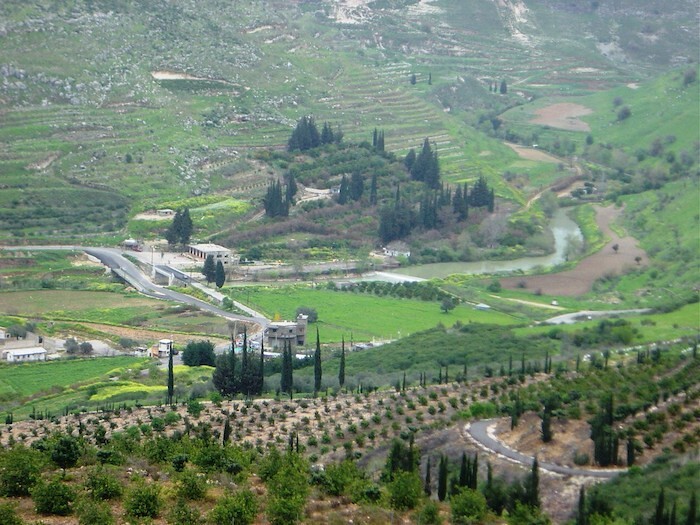

Akkar region, North Lebanon. Photo by Rami Zurayk.
The socioecological evolution of Lebanon’s terrace landscape
Evidence that human activities and livestock grazing altered the landscape of the Levant dates back to at least six millennia.7 During this period, the iconic stone-walled bench terraces constituted the keystone over which Mediterranean societies were constructed. Archeological evidence indicates that the rise and fall of civilizations in the Eastern Mediterranean might have been linked to the maintenance and neglect of these mountain terraces.8
Mountains in Lebanon cover three quarters of the land area, and half the country’s cultivated lands are on mountain slopes. Terrace farming is an ecological and a survival necessity.9 The evolution of this landscape reveals the social, political, economic, and ecological history of the country. Every terrace carved in the flank of Mount Lebanon is a unique verse of an epic poem recounting the story of the mountain and its people. Throughout the ages, the terraces of Mount Lebanon have experienced much ebb and flow. When terraces were sturdy and well maintained, so were local livelihoods. And when terraces were abandoned and left to decay, people and nature paid the price.
The Years of the Triad
Historically, the drought-tolerant oak-carob-terebinth association covered the lower elevations of Mount Lebanon, while conifers—notably pine, cedar, and juniper—dominated the higher altitudes.10 As the number of settlers increased, however, so did the concurrent demand on food and timber, which led to an increase in the area of terraced land at the expense of the forest. Grazing extended beyond the tree zone to the denuded highlands, the jurd. According to Faruk Tabak, this trend accelerated during the relatively warm period from 1450–1550.11 This was when trade-induced deforestation, driven by an increased demand for precious wood essences, peaked, and terrace construction failed to keep up with the felling of woodlands. The deforestation of the hillsides increased soil erosion and resulted in a general decline in soil fertility. This, in turn, undermined the sustainability of local livelihoods.
The Columbian Exchange brought new crops to the region and significantly modified its socioecological landscape.12 The new plants were quickly integrated into the local diet, especially that of the peasants and the poor. They included beans, corn, and potatoes, which served as both food and feed. While these crops were initially grown on the plains, pestilence and crop disease pushed them towards the higher altitudes, where they were intercropped with the traditional fruit tree on the stone-walled terraces. This led to the renaissance of the mountain and ushered a revival of its former integrated agroecology with transhumant flocks in the jurd, wheat and irrigated crops on the plateau and valley floors, and olives and vines on the stony slopes. At the turn of the nineteenth century, Lebanon’s agrarian landscape was typically Levantine. Wheat fields and olive groves, along with maize, figs, wine, and vegetables, populated most of the terraced lands.
The Years of Silk
The mid-nineteenth century saw Lebanon’s integration into global capitalism, accompanied with a major disruption of the socioecological order. Agricultural value chains were directed towards Europe, the most important of which was silk.13 The cultivation of the silkworm, whose cocoons are harvested to produce natural silk, requires large quantities of mulberry trees, which are well adapted to the ecology of the Lebanese mountains. Mulberry trees were not new to the region; they had been produced in limited quantities on the lower altitude terraces since the seventh century BCE. But the number of mulberry trees quickly multiplied during the second half of the nineteenth century, driven by French demand for silk following the French military intervention in Mount Lebanon during the 1860 civil war.14 Silk became a monoculture, and in the early twentieth century, there were twenty-eight-million trees planted in Mount Lebanon, occupying between forty-to-eighty-percent of the cultivated land. Mulberry planting expanded onto the fragile hillsides and uplands that were once dedicated to extensive grazing, which exposed the bare land to intense rainfall. Terracing was not sufficient to counter the problem of erosion in this vulnerable ecological zone. The Mountain of Adonis was stretched to its limits.
Silk quickly dominated the national and local economies, going from being a source of supplemental income to becoming the main cash crop of peasant families. Lebanon became dependent on European (essentially French) trade, and its markets were flooded with European goods. A new consumption society emerged and spread among the peasants who, in order to avoid sinking under heavy debts, had no option but to produce more cocoons. And because mulberry trees and silk were very time-intensive, the production of subsistence crops such as wheat and lentils declined, and peasants were often forced to borrow money to supply their families with food.15 The failure of the global silk market in the first decade of the twentieth century initiated a movement of mass migration to the Americas.
Silk production also led to a major evolution in social relations, especially land tenure. Prior to the silk boom, most of the land was in large parcels controlled by local nobles who paid taxes to the Ottoman state. In order to increase profits from silk production, more land needed to be terraced and planted with mulberry trees. New forms of contracts appeared, in which peasants who would provide labor for terracing and care for the trees for a period of five to seven years could retain one quarter of the newly terraced land after their contract expired. This led both to the deforestation of larger areas and to the division of land into small parcels. The peasantry became less dependent on landlords, and both peasant and landlords became dependent on merchants.16 Temporary prosperity led to enlarged peasant families, and thus to a further subdivision of the lands through inheritance. Farm size fell below what was economically viable, which drove emigration further.
The integration of Lebanon into world markets and the dominance of silk also drove a significant a change in food consumption habits. Imports of sugar rose fourfold in the last third of the nineteenth century. Burghul, or parboiled crushed bread, which was a main staple of the Lebanese diet, was replaced with rice, whose imports increased from none in 1840 to 8,000 tons in 1888 in the Beirut port alone.17 For an estimated population of 500,000 in the territories that form today’s Lebanon, this would be equivalent to an annual consumption of sixteen kilograms of rice per person, which is similar to the per capita consumption in 2017.18 And because the cultivation of subsistence crops had almost entirely ceased, the peasants in Mount Lebanon became totally dependent on imports from Syria for food supply. Consequently, when the allied and axis forces clashed in the Levant during World War One, the resulting blockade led to the starvation of hundreds of thousands of Lebanese people and to the death and emigration of an estimated two-thirds of the population of Mount Lebanon towards the Americas. To this day, this famine, also known as The Great Syrian Famine, remains deeply etched into the collective memory of the people of the mountain.19
The Years of Ares and Oil
The first wave of migration from the mountain both towards Beirut and abroad coincided with the expansion of the silk industry and its integration into the French market. It was initially driven by the weakening of the feudal system and the atomization of landholdings. World War One hastened the process, and after the famine of 1916–18, many villages were partly or wholly deserted and most land went out of cultivation. The virtual destruction of the silk market by 1930 drove even more people out of agriculture.20 The terraced lands, especially that which had been recently expanded onto in the marginal rangelands, fell into a state of disrepair. Where forests were cut and the land laid bare, the intense storms of the mountain dug deep furrows and gullies. Lands that were once cultivated were now abandoned, and disorder and economic recession took hold of the mountain. Erosion rates multiplied and the rivers ran redder than ever.
With time, nature took over, rolling out secondary ecological successions. Forests regenerated on some of the abandoned agricultural terraces.21 These new arbored patches coexisted with difficulty with overstocking and poorly managed grazing, as many landowners preferred renting out their parcels to transhumant herders instead of cultivating them. During the French Mandate over Lebanon (1920–1943), large influxes of foreign capital penetrated the Lebanese economy, but they were essentially aimed at improving the financial, commercial, and communication sectors. Rural areas and the agricultural sector remained neglected. This approach persisted after Lebanon’s independence in 1943 as Beirut became a haven for foreign capital from both Europe and other Arab states.22
Apple production started to appear on some former mulberry terraces after the country’s independence, but was weakened by Lebanon’s liberal economic policies, as well as by the lack of interest of absentee landlords in land improvement. Moreover, poorer peasants were unable to incur the heavy capital cost of terrace repair, buying good fruit stocks, and waiting several years for an economic profit to materialize. Additionally, the limited support to agriculture in the nascent Lebanese state accelerated the fall of smallholder farmers in a spiral of poor land husbandry and low financial returns.
As oil production intensified in the Gulf States, much of its massive rent was funneled into Lebanon’s real estate and tourism. This had a large impact on Mount Lebanon, which became a playing field of heavy machinery, tearing the rocks and sweeping the soil in order to build luxurious villas for visitors from the Gulf. The Lebanese state facilitated this assault by abolishing real estate rental codes and facilitating large foreign real estate ownership.23 Moreover, the state never regulated land use planning, and to this day, construction can take place on all lands in Lebanon. Meanwhile, intranational migration was occurring from village to city: during the 1960s alone, one-fifth of Lebanon’s rural population migrated to towns and cities, and primarily Beirut.24 Remittances that flowed back often “permitted recipient families to purchase land qua land, but not generally with the cultivation of this land in mind.”25
The promotion of real estate investment, as well as the pressure caused by the diaspora seeking to purchase land in their ancestral villages, led to the creation of a real estate bubble. Demand-driven speculations resulted in farmland being valued for its “exchange value” associated with its real estate potential rather than for its “use value” in productive agriculture. These new sources of income and capital provided rural people with the means to build livelihoods divorced from farming. With these changes in livelihood strategies came further decline in the use of the forest and rangelands.
The chaos accompanying the Lebanese civil war (1975–1991) fortified these trends, although some temporary return migration was experienced as urban migrants were driven out of the cities by street fighting and indiscriminate shelling. The new millennium brough a period of civil peace, accompanied by a policy of post-war reconstruction and further integration into global markets. Driven by the city’s gargantuan appetite for (re)construction material, sand and limestone quarries spread like wildfire on Mount Lebanon. The tusks of Ares dug further into Adonis’s groin, and the rivers ran redder than ever, carrying sediments from degrading terraces in addition to the exposed gashes of the quarries. Agriculture’s share of national GDP fell to reach 3.2% in 2018. Some terraces are still farmed, but Lebanon’s liberal economic policies, coupled with capital penetration into export-driven agriculture, have turned the peasant into what Akram-Lodhi and colleagues term “small-scale petty commodity producers.”26 Agriculture in Lebanon is today largely transitional. It is practiced only until the land is sold for real estate. In this new optic, there is no place for the maintenance of soil fertility. Lebanon’s metabolic rift runs deep through the heart of a land that has been robbed of its nurturing function.27
As I write the final words of this essay, on February 1, 2021, Lebanon is bleeding. Gored from all sides by a triple economic, financial, and banking crisis, by the Covid-19 pandemic, and by the Beirut explosion, the country is convulsing. Emigration is hindered by the barriers of global economic recession, the global rise of populist nationalism, and myriad geopolitical pressures. The state is spending its last reserves of hard currency on subsidizing essential food imports. There are talks of famine. Across the nation, many have heard the call of the land and are starting to rebuild and replant the terraces. The Lord Adon sleeps serenely, pressed to the chest of Ishtar.
The major rivers of the Fertile Crescent: Tigris and the Euphrates, the Orontes, the Litani and the Jordan.
Located on the Mediterranean shores of South West Asia, Lebanon’s 10,452 square kilometers form the crossroads of Asia, Africa and Europe. Its 220-kilometer coastline runs northeast to southwest. The adjoining narrow coastal plain the two parallel mountain ranges enclosing the fertile Beqaa plain form its main physiographic features. The country’s width varies between fifteen kilometers and eighty-five kilometers, with an average of fifty kilometers.
Ovid, “Adonis transformed,” in Metamorphoses: Book 10, trans. Brookes More (Boston: Cornhill Publishing Co., 1922).
Also known as the Ibrahim river, for Abraham, who, like Tammuz, came from Ur in Mesopotamia.
Coined by Faruk Tabak. See Faruk Tabak, The Waning of the Mediterranean, 1550–1870: A Geohistorical Approach (Baltimore: Johns Hopkins University Press, 2007).
C. Neil Roberts et al., “Mediterranean landscape change during the Holocene: Synthesis, comparison and regional trends in population, land cover and climate,” The Holocene 29, no. 5 (2019): 923–937.
See, for example, Gary O. Rollefson and Ilse Köhler-Rollefson, “Early neolithic exploitation patterns in the Levant: Cultural impact on the environment,” Population and Environment 13 (1992): 243–254.
Daniel Hillel, Out of the Earth: Civilization and the Life of the Soil (New York: The Free Press, 1991).
Writing in 1936, Andre Latron singles out the Lebanese mountain village as an example of a cooperative society where collaboration is a survival necessity. “A terrace can never be completely individualized. It belongs, because of the specific nature of the land, to an organized whole from which it can never be removed.” Author’s translation from Andre Latron, La vie rurale en Syrie et au Liban (Damascus: Institut Francais de Damas, 1936).
Ihab Jomaa et al., “Analysis of Eastern Mediterranean Oak Forests Over the Period 1965–2003 Using Landscape Indices on a Patch Basis,” Landscape Research 34, no. 1 (2009): 105–124.
Tabak, The Waning of the Mediterranean.
The Columbian Exchange, initiated by Columbus’s voyage across the Atlantic in 1492, refers to the flow of animals, plants and ideas between the Americas, West Africa and the Old World.
Akram Fouad Khater, “‘House’ to ‘Goddess of the House’: Gender, Class, and Silk in 19th-Century Mount Lebanon,” International Journal of Middle East Studies 28, no. 3 (1996): 325-348.
The 1860 civil war in Lebanon opposed the traditional inhabitants of the mountain, the Druze and the Maronites. France intervened on behalf of the Maronites whom it placed under its protection.
Khater, “‘House’ to ‘Goddess of the House.’”
Kais Firro, “Silk and Agrarian Changes in Lebanon, 1860–1914,” International Journal of Middle East Studies 22, no. 2 (1990): 151–169.
Parboiled crushed wheat was the main staple of the Lebanese diet along with bread. See David R. W. Jones, “Apple Production in the Lebanon: A Study of Agricultural Development in an under-Developed Area,” Economic Geography 39, no. 3 (1963): 245–257.
J.M. Wagstaff, “A Note on Some Nineteenth-Century Population Statistics for Lebanon,” Bulletin (British Society for Middle Eastern Studies) 13, no. 1 (1986): 27–35. See also Helgi Analytics, “Rice Consumption Per Capita in Lebanon,” Helgi Library, 2020, ➝.
Lebanon was part of the Syrian region until the creation of the Greater Lebanon under French Mandate in 1920.
Jones, “Apple Production in the Lebanon.”
Jomaa et al., “Analysis of Eastern Mediterranean Oak Forests.”
Carolyn Gates, The Historical Role of Political Economy in the Development of Modern Lebanon (Oxford: Oxford Centre for Lebanese Studies, 1989).
Enshrined in Decree 11614 in 1969, reinforced by Law 296 in 2001.
Salim Nasr, “Backdrop to Civil War: The Crisis of Lebanese Capitalism,” MERIP Reports 73 (December 1978): 3–13.
Jones, “Apple Production in the Lebanon.”
A. Haroon Akram-Lodhi and Cristóbal Kay, “Surveying the agrarian question (part 1): unearthing foundations, exploring diversity,” The Journal of Peasant Studies 37, no. 1 (2010): 177–202.
Jason W. Moore, “Metabolic rift or metabolic shift? dialectics, nature, and the world-historical method,” Theory and Society 46 (2017): 285–318.
Exhausted is a collaboration between SALT and e-flux Architecture, supported by L’internationale and the Prince Claus Fund.
